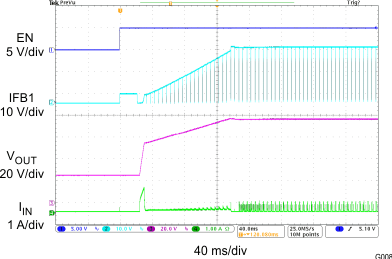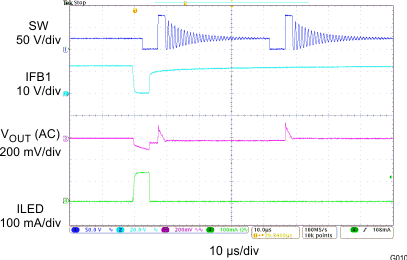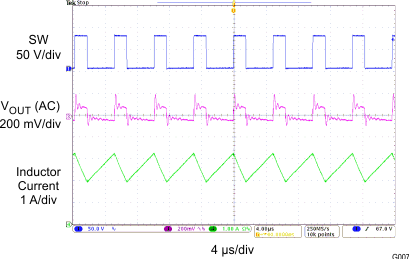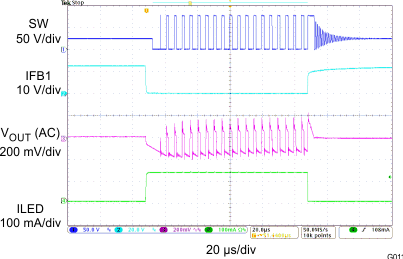| POWER SUPPLY |
| VIN |
Input voltage range |
|
8 |
|
30 |
V |
| VVIN_UVLO |
Undervoltage lockout threshold |
VIN falling |
|
6.5 |
7 |
V |
| VVIN_HYS |
VIN UVLO hysteresis |
|
|
300 |
|
mV |
| Iq_VIN |
Operating quiescent current into VIN |
Device enabled, no switching, VIN = 30 V |
|
|
2 |
mA |
| ISD |
Shutdown current |
VIN = 12 V,
VIN = 30 V |
|
|
25
50 |
µA |
| VDD |
Regulation voltage for internal circuit |
0 mA < IDD < 15 mA |
5.7 |
6 |
6.3 |
V |
| EN and PWMx |
| VH |
Logic high input on EN,PWMx |
VIN = 8 V to 30 V |
1.8 |
|
|
V |
| VL |
Logic low input on EN, PWMx |
VIN = 8 V to 30 V |
|
|
0.8 |
V |
| RPD |
Pull-down resistance on EN, PWMx |
|
0.8 |
1.6 |
3 |
MΩ |
| UVLO |
| VUVLOTH |
Threshold voltage at UVLO pin |
|
1.204 |
1.229 |
1.253 |
V |
| IUVLO |
UVLO input bias current |
VUVLO = VUVLOTH – 50 mV
VUVLO = VUVLOTH + 50 mV |
–0.1
–4.3 |
-3.9 |
0.1
–3.3 |
µA |
| SOFT START |
| ISS |
Soft start charging current |
PWM ON, VREF< 2 V
PWM ON, VREF> 2 V |
|
200
10 |
|
µA |
| CURRENT REGULATION |
|
| VISET |
ISET pin voltage |
|
1.217 |
1.229 |
1.240 |
V |
| IISET_P |
ISET short-to-ground protection threshold |
|
120 |
150 |
180 |
µA |
| KISET |
Current multiple IIFB/IISET |
IISET = 32.56 µA, VIFB = 0.5 V |
3932 |
3992 |
4052 |
|
| IIFB(AVG) |
Current accuracy |
IISET = 32.56 µA, VIFB = 0.5 V |
127.4 |
130 |
132.6 |
mA |
| KIFB(M) |
Current matching; (IFB(MAX)-IFB(MIN))/2IFB(AVG) |
IISET = 32.56 µA, VIFB = 0.5 V |
|
0.5% |
1.5% |
|
| IIFB_LEAK |
IFB pin leakage current at dimming off |
IFB voltage < 40 V |
|
|
1 |
µA |
| IIFB_max |
Current sink max output current |
VIFBV = 350 mV |
130 |
|
|
mA |
| IFB REGULATION VOLTAGE |
| VIFB |
Regulation voltage at IFB |
Measured on VIFB(min), other IFB voltages are 0.5 V above VIFB(min).
IIFB = 130 mA, VIFBV = 0.5 V |
|
508 |
|
mV |
| IIFBV |
IFB Regulation voltage setting sourcing current at IFBV |
VIFBV = 0.5 V |
0.247 |
0.25 |
0.253 |
IISET |
| VIFBV |
IFBV voltage setting range |
|
0.3 |
|
1 |
V |
| BOOST REFERENCE VOLTAGE |
| VREF |
Reference voltage range for boost controller |
|
0 |
|
3.1 |
V |
| IREF_LEAK |
Leakage current at REF pin |
|
–25 |
|
25 |
nA |
| OSCILLATOR |
| VFSW |
FSW pin reference voltage |
|
|
1.8 |
|
V |
| VFSW_H |
Logic high input voltage |
|
3.5 |
|
|
V |
| VFSW_L |
Logic low input voltage |
|
|
|
0.5 |
V |
| ERROR AMPLIFIER |
| ISINK |
Comp pin sink current |
VOVP = VREF + 200 mV, VCOMP = 1 V |
|
20 |
|
µA |
| ISOURCE |
Comp pin source current |
VOVP = VREF – 200 mV, VCOMP = 1 V |
|
20 |
|
µA |
| GmEA |
Error amplifier transconductance |
|
90 |
120 |
150 |
µS |
| REA |
Error amplifier output resistance |
|
|
20 |
|
MΩ |
|
|
|
|
|
|
|
| GATE DRIVER |
| RGDRV(SRC) |
Gate driver impedance when sourcing |
VDD = 6 V, IGDRV = –20 mA |
|
2 |
3 |
Ω |
| RGDRV(SNK) |
Gate driver impedance when sinking |
VDD = 6 V, IGDRV = 20 mA |
|
1 |
1.5 |
Ω |
| IGDRV(SRC) |
Gate driver source current |
VGDRV = 5 V |
200 |
|
|
mA |
| IGDRV(SNK) |
Gate driver sink current |
VGDRV = 1 V |
400 |
|
|
mA |
| VISNS(OC) |
Overcurrent detection threshold |
VIN = 8 V to 30 V, TJ = 25°C to 125°C |
376 |
400 |
424 |
mV |
| OVERVOLTAGE PROTECTION (OVP) |
| VOVPTH |
Output voltage OVP threshold |
|
2.95 |
3.02 |
3.09 |
V |
| IOVP |
Leakage current |
|
–100 |
0 |
100 |
nA |
| VIFB_OVP |
IFBx over voltage threshold |
PWM ON |
|
38 |
|
V |
| LED SHORT DETECTION |
| IFBP |
LED short detection sourcing current |
VFBP = 1 V |
0.247 |
0.25 |
0.253 |
IISET |
| FAULT INDICATOR |
| IFLT_H |
Leakage current in high impedance |
VFLT = 24 V |
|
1 |
|
nA |
| IFLT_L |
Sink current at low output |
VFLT = 1 V |
1 |
2 |
|
mA |
| THERMAL SHUTDOWN |
| Tshutdown |
Thermal shutdown threshold |
|
|
150 |
|
°C |
| Thys |
Thermal shutdown threshold hysteresis |
|
|
15 |
|
°C |

















